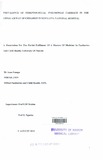| dc.contributor.author | Irungu, Anne | |
| dc.date.accessioned | 2013-05-24T10:00:40Z | |
| dc.date.available | 2013-05-24T10:00:40Z | |
| dc.date.issued | 2010 | |
| dc.identifier.citation | Masters Of Medicine In Paediatrics And Child Health | en |
| dc.identifier.uri | http://erepository.uonbi.ac.ke:8080/xmlui/handle/11295/25361 | |
| dc.description.abstract | Background: A study of the pneumococcal colonisation of the upper airway of children is a
useful way of determining the resistance patterns of the bacteria to the commonly used
antibiotics in our country. Regular pneumococcal disease surveillance and resistance testing
is rarely done in public hospitals in developing countries like ours, limiting our ability to
effectively manage the invasive diseases it causes like Meningitis and Pneumonia The
findings of this study will be useful in guiding our current antibiotic regimes used in the
treatment of Pneumococcal disease.
Objectives: To study the prevalence of upper airway carriage of Streptococcus pneumoniae
for children less than five years and also obtain upper airway bacterial isolates to study the
antibiotic sensitivity of pneumococcus.
Methods: This was a hospital-based cross-sectional survey, recruiting 250 patients aged 0-59
months from the paediatric filter clinic and the wards. The parents/guardians were required to
give a written consent, fill in a questionnaire then oropharyngeal samples were taken (throat
swabs) from their children. These samples were cultured for pneumococcus using standard
lab methods and its antibiotic sensitivity tested.
Setting: Kenyatta National Hospital (KNH), it serves as a primary facility for its urban
hinterland and is also a tertiary national referral hospital. Patients were recruited from the
paediatric out-patient filter and emergency clinic (pEU).
7
Results: The prevalence of the upper airway colonisation of pneumococcus was 10.8%. The
range of age of carriage was 2-60 months with a median age of 13 months and a mean of 16.8
months. Amoxicillin and Cotrirnoxazole showed complete resistance against all the isolates
tested. The other Penicillin antibiotics also showed high resistance. Ceftriaxone, Gentamicin
and Chloramphenical showed no resistance with Erythromicin and the other Cephalosporin
antibiotics also showing high sensitivity.
Conclusion: The oropharyngeal carriage rate of pneumococcus in children under five at
KNH is 10.8%. In this study Cephalosporin antibiotics have a high sensitivity against
pneumococcus compared to Penicillin antibiotics and Cotrimoxazole which have high
resistance rates. Chloramphenical, Erythromicin and the Aminoglycosides; Gentamicin and
Amikacin also showed high sensitivity rates.
Recommendations: Cephalosporins, Aminoglycosides and Chloramphenical should be used
as the first-line antibiotics in the treatment of suspected pneumococcal disease in this
hospitaL Macrolides like Erythromicin also showed efficacy against pneumococcus.
Penicillin antibiotics and Cotrimoxazole should not be used in the treatment of pneumococcal
disease. Regular surveillance for antibiotic resistance should be done in this hospital and
treatment guidelines should be changed according to the current trends. | en |
| dc.language.iso | en | en |
| dc.publisher | University of Nairobi | en |
| dc.title | Prevalence of streptococcal pneumoniae carriage in the Upper airway of children in Kenyatta National Hospital | en |
| dc.type | Thesis | en |
| dc.description.department | a
Department of Psychiatry, University of Nairobi, ; bDepartment of Mental Health, School of Medicine,
Moi University, Eldoret, Kenya | |
| local.publisher | College of Health Sciences | en |

